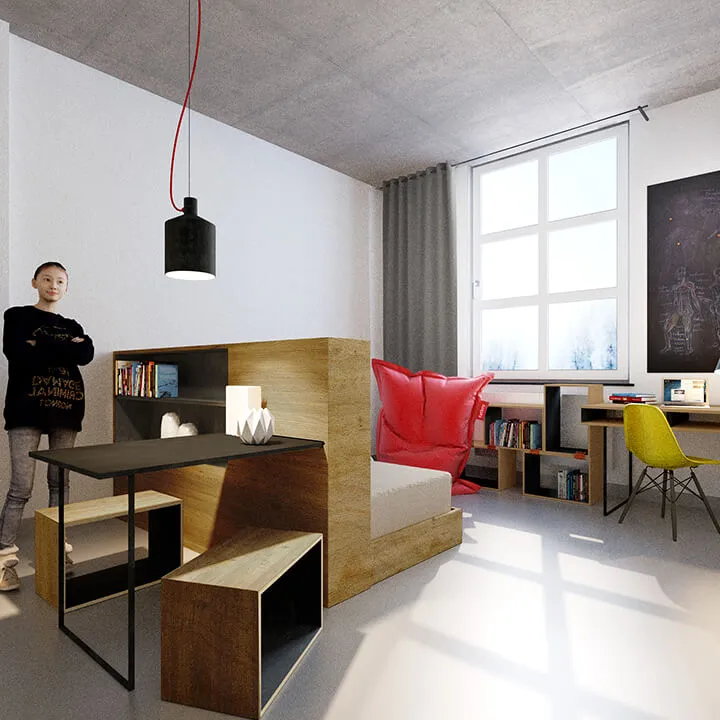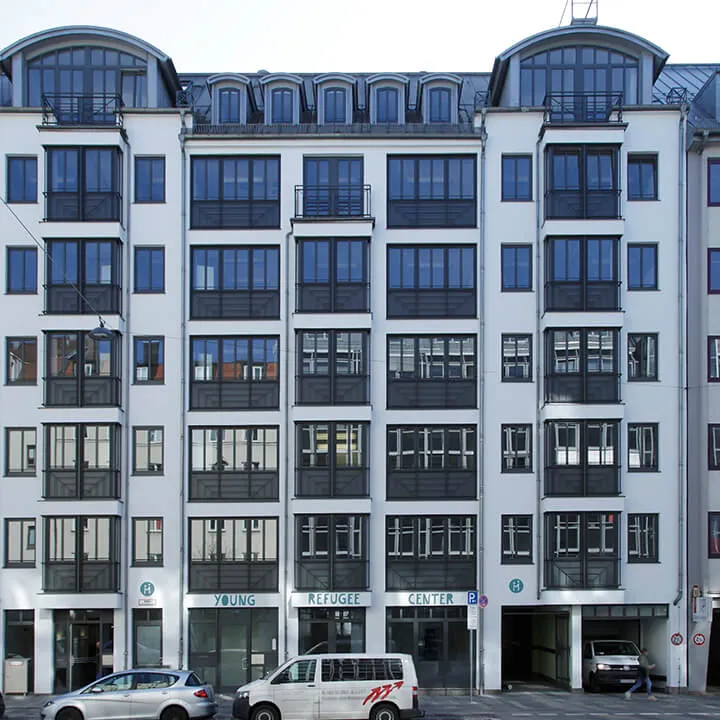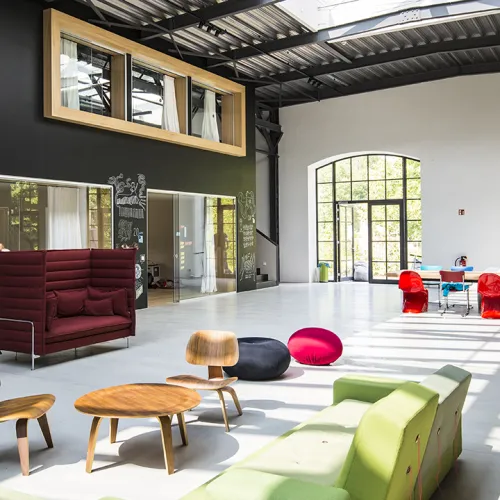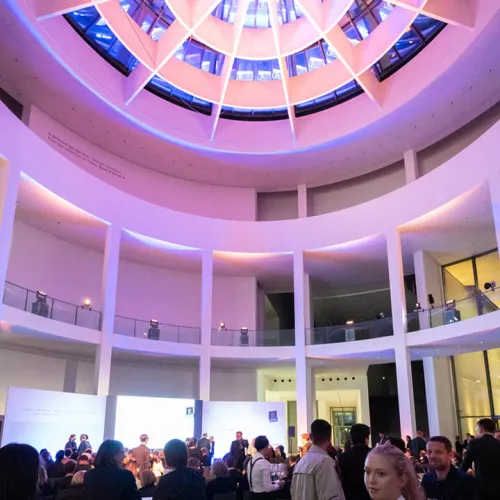Office and commercial buildings from the 60s are the new cool
- About 70 percent of non-residential buildings in Germany are older than 40 years.
- The most frequent reasons for redevelopment instead of new build are co2 and cost savings.
- Location is often more important than the structure of a building or statistics
Munich, November 23, 2017. Department stores, office buildings, data centers: Around 70 percent of all existing non-residential buildings in Germany are older than 40 years - and many of them are no longer en vogue regarding their originally intended use. This is why owners of older real estate are increasingly confronted with the question of refurbishment, re-development or demolition and new construction, not only in Germany, but throughout Europe. The answer to this has become increasingly in recent years a decision for re-development often paired with a complete reuse. "Many buildings have an architectural, historical or urban significance. Last but not least, a stronger environmental awareness and economic reasons often play a major role in the decision against demolition and new construction," mentions Reiner Nowak, Managing Director of CSMM GmbH, as the main reasons for the rethink.
Consulting and architecture companies such as CSMM are increasingly being hired for projects in which the existing building fabric is to be preserved and made fit for new user requirements. "In addition to project development and classic tenant fit-out, re-development now accounts for over one third of our projects - and the number is increasing," says Reiner Nowak.
A large proportion of commercial real estate in Germany - especially from the post-war period until the 1990s - is today with regards to the real estate cycle in the so-called change or critical phase. They have peaked in terms of profitability, rents are falling and vacancy is spreading. In this phase, the real estate is usually no longer up to date in terms of energy and re-letting is hardly possible. Therefore, owners have to ask the question: demolish or re-develop?
Financial evaluation with regard to resource conservation, investment and return
Reiner Nowak: "Re-development makes sense in many cases. Not only does it cost less than new construction, it also consumes less energy. Most importantly, it creates flexible and future-proof space in existing structures for users and tenants to withstand the paradigm shift of digitization and globalization."
According to the re-development expert, redevelopment or complete conversion, as well as demolition and new construction, all involve dismantling costs. However, owners save the entire excavation and shell construction costs by preserving the building fabric. And according to CSMM, they make up a good 25 to 30 percent of the total construction costs. Depending on the project this could save several million euros.
Owners of older commercial properties can through re-development also significantly reduce their ecological footprint compared to new build. Anyone who retains existing structures saves on a major energy consumer by eliminating the use of steel or concrete and CO2-intensive cement extraction. "The construction industry directly or indirectly causes about a quarter of the carbon dioxide emissions of all industrial and combustion processes worldwide. The production of cement alone accounts for around five percent of global CO2 production, with the carbon dioxide released during the manufacturing process of building materials even accounting for 90 percent of the global carbon dioxide emissions of the construction industry."
Re-development rarely fails due to building substance and statics
When assessing whether an object is suitable for re-development, owners often fear that they could no longer meet today's user requirements. But Reiner Nowak is less concerned. "Overhauling an existing façade in an architecturally interesting way and bringing it up to date with today´s energy saving requirements is rarely a problem. Also, I'm always amazed at how flexible buildings are in their floor plans and so can be adapted to current user requirements. There`s a reason why, for example, buildings from the 1960s are considered cool again today. After a clever transformation, they are particularly on trend and suitable for open, large-scale office structures."
Even with regard to building substance and statics, re-development rarely fails after the many years of experience of the CSMM expert. Not least, today's fire protection regulations can be easily implemented as a result of gutting and reinstalling all MEP services.
However, parameters such as natural lighting and natural ventilation through sufficiently available windows and suitable building depths also play a major role in the object’s evaluation. "Although many functions can be mechanically installed if they are not already present in the building structure, the cost-intensive renovation of MEP services often means high investment and operating costs. Therefore, the so-called 'low-tech' approach, especially with regard to ventilation and lighting of the buildings, should always be taken into account, "says Reiner Nowak. The prerequisite for this, according to Nowak, is that the floor plans are not designed too deeply, so that daylight reaches the workplaces and the area can be adequately ventilated by opening the windows. Combining this approach with smart technology not only enhances environmental protection, but also enhances the well-being of the future building user.
Building law evaluation with regard to extension, densification and use
Extensions in the horizontal as well as in the vertical to increase property values are also often possible. According to Nowak, almost every building can be extended upwards by one to two floors – with the necessary consent of the local authorities. Horizontal extension to the side or rear of a building can also quite often - depending on the local building law provisions – be realized.
Successful sustainable re-development considers the site location and potential users in the planning
However, consulting services for an effectively planned re-development strategy provided by holistically-oriented architectural firms such as CSMM always look beyond the building itself by carefully analysing the site, the wider market and socioeconomic parameters: Is it an A, B or C location? How likely is a fast re-letting due to the location? Which users are considered at the location? What requirements do these users have for a building and can these be implemented on site? Reiner Nowak: "The best design is of no use if the location is not suitable for a re-development. Therefore, only after thorough location and feasibility studies should consultants and architects present the owners with a comprehensive re-development concept including equally design concepts, measures for resource conservation and user marketing."
Pressekontakt
scrivo PublicRelations GbR
Ansprechpartnerin: Nadine Anschütz
Elvirastraße 4, Rgb.
80636 München
Tel.: +49 (0)89 45 23 508-10
Fax: +49 (0)89 45 23 508-20
E-Mail: nadine.anschuetz@scrivo-pr.de
Web: www.scrivo-pr.de
Unternehmenskontakt
Modal M GmbH
Werk 3, Atelierstraße 14 / C
81671 München
Tel.: +49 (0)89 599 890 88-0
Fax: +49 (0)89 599 890 88-99
E-Mail: info@cs-mm.com
Web: www.modal-m.com




Über Modal M – landlord and investor consulting
Standortbewertung, architektonische Gesamtplanung, kreative Vermarktungsstrategien, maßgeschneiderte Kommunikations- und Werbemaßnahmen: Im originären Sinne einer umfassenden Architekturleistung steuert Modal M als Berater und Generalplaner sämtliche baulichen und kommunikativen Prozesse für den erfolgreichen Um-, Aus- oder Neubau von Immobilien im Gewerbebereich. Dabei vertrauen namhafte und anspruchsvolle Investoren, Entwickler, Vermieter und Eigentümer aus Deutschland, dem europäischen Ausland und den USA seit 2008 auf das Know-how des in München gegründeten Unternehmens. Das 50-köpfige, interdisziplinär und international zusammengesetzte Team ist spezialisiert auf Büros, Hotels und Gastronomie jeder Größenordnung. Die Geschäftsführung von Modal M obliegt Timo Brehme, Reiner Nowak und Malte Tschörtner. Neben dem Münchner Stammsitz betreibt das Unternehmen Dependancen in Berlin, Frankfurt a.M., Düsseldorf und Wien.
Modal M ist aktiv in der Deutschen Gesellschaft für Nachhaltiges Bauen e.V. – DGNB und fördert gif – die Gesellschaft für Immobilienwirtschaftliche Forschung e.V. Darüber hinaus kooperiert das Unternehmen seit 2014 mit der Fakultät Architektur an der Ostbayerischen Technischen Hochschule in Regensburg.




